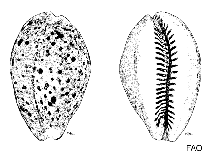Monetaria caputdraconis (Melvill, 1888)
| Native range | All suitable habitat | Point map | Year 2050 |

|
| This map was computer-generated and has not yet been reviewed. |
| Monetaria caputdraconis AquaMaps Data sources: GBIF OBIS |
Upload your photos
Google image | No image available for this species;
drawing shows typical species in Cypraeidae.
Google image | No image available for this species;
drawing shows typical species in Cypraeidae.
Classification / Names Common names | Synonyms | CoL | ITIS | WoRMS
Gastropoda | Littorinimorpha | Cypraeidae
Environment: milieu / climate zone / depth range / distribution range Ecology
Demersal; depth range 0 - 30 m (Ref. 94005). Subtropical
Distribution Countries | FAO areas | Ecosystems | Occurrences | Introductions
Southeast Pacific: Easter Island and Sala y Gómez. Endemic to Easter Island.
Length at first maturity / Size / Weight / Age
Maturity: Lm 2.9, range 2 - 4.01 cm Max length : 3.5 cm ShL male/unsexed; (Ref. 8763)
Life cycle and mating behavior Maturity | Reproduction | Spawning | Eggs | Fecundity | Larvae
Egg mass incubated and protected by the female under her foot (Ref. 93583). Female: stage F1 (initial maturity) - gonad yellow, gonadal acini with active initial oogenesis, germinal line with small oogonia and initial previtellogenic oocytes bearing germinal vesicle; stage F2 (peak maturity) - gonad yellow, gonadal acini with complete oogenesis, germinal line filled with free and very large vitellogenic oocytes; stage F3 (regression or post-gamete release, with occasional gonadal recovery) - gonad cream or brown, gonadal acini contracted. Male: stage M1 (initial maturity) - gonad orange, acini with early germinal line, spermatogonia and spermatocytes predominate, penis present; stage M2 (peak maturity) - gonad orange, complete germinal line in gonadal acini; elongate spermatids arranged in tiers filling the acini lumen; stage M3 (regression or maximum release) - gonad translucent, gonadal acini occupied by few residual spermatids of a prior release. The species is reproductively active year-round. More than one male could compulate with a female.
Main reference
References | Coordinator | Collaborators
Heiman, E. 2007. (Ref. 8761)
IUCN Red List Status (Ref. 130435: Version 2024-1)
CITES status (Ref. 108899)
Not Evaluated
CMS (Ref. 116361)
Not Evaluated
Threat to humans
Human uses
Fisheries: commercial
| FishSource |
Tools
More information
Trophic Ecology
Food items
Diet
Food consumption
Ration
Predators
Diet
Food consumption
Ration
Predators
Ecology
Population dynamics
Life cycle
Distribution
Human Related
Aquaculture profile
Stamps, Coins Misc.
Stamps, Coins Misc.
Outreach
Taxonomy
References
Internet sources
BHL | BOLD Systems | CISTI | DiscoverLife | FAO(Publication : search) | Fishipedia | GenBank (genome, nucleotide) | GloBI | Gomexsi | Google Books | Google Scholar | Google | PubMed | Tree of Life | Wikipedia (Go, Search) | Zoological Record



